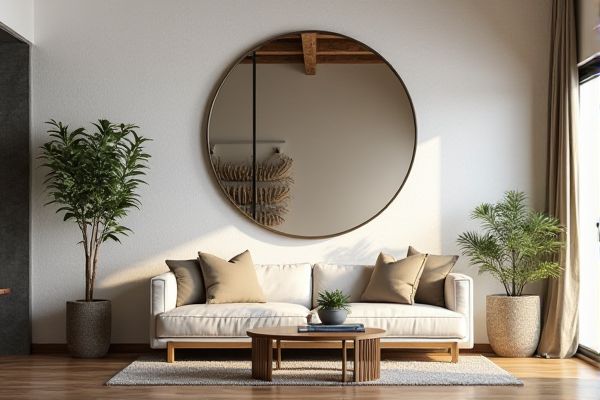
Outdoor mirrors enhance your garden or patio with reflective depth and light, creating the illusion of expanded space, while wall art focuses on adding color, texture, and personality to outdoor settings. Explore the article to discover which option best elevates your outdoor aesthetic and suits your unique style.
Table of Comparison
| Feature | Outdoor Mirror | Wall Art |
|---|---|---|
| Purpose | Reflects light and space outdoors | Decorative visual appeal |
| Material | Weather-resistant glass and frame | Varied materials: canvas, metal, wood |
| Durability | High, designed for outdoor elements | Variable, depends on material and protection |
| Placement | Gardens, patios, entryways | Indoor walls, some outdoor walls with protection |
| Functionality | Enhances outdoor space with reflection | Enhances aesthetics and theme |
| Maintenance | Requires cleaning to avoid dirt spots | Depends on material, generally low |
| Cost | Moderate to high due to durability | Varies widely by type and size |
Introduction to Outdoor Decor: Mirrors vs Wall Art
Outdoor decor transforms your space by reflecting natural light and enhancing ambiance. Outdoor mirrors create an illusion of expanded space and amplify brightness, making your garden or patio feel larger and more inviting. Wall art adds personality and color, serving as a focal point that complements the surrounding environment with style and creativity.
Aesthetic Impact: Enhancing Spaces with Mirrors and Art
Outdoor mirrors reflect natural light and scenery, creating an illusion of expanded space while enhancing the aesthetic appeal of your garden or patio. Wall art adds color, texture, and personality, transforming plain surfaces into expressive focal points that reflect your style. Choosing between an outdoor mirror and wall art depends on whether you want to amplify natural surroundings or showcase artistic expression in your outdoor area.
Material Durability: Weatherproofing Essentials
Outdoor mirrors made with tempered glass and rust-resistant aluminum frames offer superior durability against harsh weather conditions like rain, wind, and UV exposure. Wall art materials such as treated wood or metal often require specialized weatherproof coatings to prevent fading, warping, or corrosion. To maintain your outdoor space, choose mirrors or wall art designed with weatherproofing essentials that ensure longevity and minimal maintenance.
Installation Requirements for Outdoor Mirrors and Wall Art
Outdoor mirrors require weather-resistant materials like tempered glass and rust-proof frames, alongside secure mounting hardware to withstand wind and moisture. Wall art outdoors demands UV-protected finishes and sturdy anchors suitable for brick, wood, or stucco surfaces to prevent damage and ensure longevity. Both installations benefit from proper sealing and positioning to avoid water infiltration and maximize durability in varying weather conditions.
Reflective Light: Mirrors vs Visual Texture: Wall Art
Outdoor mirrors amplify natural light by reflecting sunlight and surrounding landscapes, creating an illusion of expanded space and increased brightness in exterior areas. Wall art introduces visual texture through varied materials, colors, and patterns, enhancing tactile interest and adding depth to outdoor decor. While mirrors optimize reflective light to brighten and open up spaces, wall art emphasizes aesthetic richness and dimensionality.
Maintenance and Longevity Comparison
Outdoor mirrors designed with weather-resistant materials, such as tempered glass and rust-proof frames, require minimal maintenance and offer enhanced longevity compared to traditional wall art. Wall art, often crafted from canvas or wood, is more susceptible to damage from moisture, UV rays, and temperature fluctuations, necessitating regular care and protective treatments. Choosing an outdoor mirror can result in a durable, low-maintenance decorative solution that withstands harsh environmental conditions effectively.
Cost Analysis: Outdoor Mirrors vs Wall Art
Outdoor mirrors typically cost more upfront than wall art due to weather-resistant materials and durable framing required to withstand elements. Wall art offers a wider price range, often providing more affordable options with less structural demand, making it suitable for various budgets. Your decision should balance long-term investment in outdoor mirrors against the budget-friendly flexibility of wall art for external or internal decoration.
Style Versatility for Exterior Spaces
Outdoor mirrors offer style versatility by reflecting natural light and expanding visual space, enhancing any exterior design from modern to rustic. Wall art adds texture and color, allowing you to express personality and complement garden themes with various materials like metal, wood, or weather-resistant canvases. Both elements transform your outdoor area, but mirrors provide functional elegance while wall art delivers artistic flair.
Safety Considerations and Outdoor Use
Outdoor mirrors require shatterproof, weather-resistant materials like acrylic or treated glass to ensure safety and durability against elements such as rain, wind, and UV exposure. Wall art designed for outdoor use must be crafted from materials that resist fading, rust, and moisture damage to maintain aesthetic appeal and structural integrity. Choosing between an outdoor mirror and wall art depends on your specific location and safety needs, prioritizing impact resistance and secure mounting.
Choosing the Best Option for Your Outdoor Area
When selecting between an outdoor mirror and wall art for your outdoor area, consider factors such as durability, aesthetic impact, and space enhancement. Outdoor mirrors can create an illusion of expanded space and reflect natural light, while wall art offers diverse styles and can serve as a focal point with vivid colors or textures. Weather-resistant materials like treated glass or metal for mirrors, and sealed wood or metal for wall art, ensure longevity and maintain visual appeal in varied climates.
 homyna.com
homyna.com